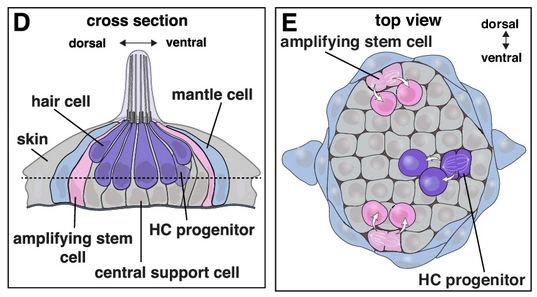Hearing Health Foundation was founded in 1958, and we’re proud to have funded groundbreaking hearing and balance research for 65 years. Our Emerging Research Grants program focusing on early career researchers means that we’ve been able to support hearing and balance scientists from when they start out early in their careers, developing their own ideas and building their own labs, onward to becoming senior investigators and mentors themselves to new cohorts of researchers.
The effect an Emerging Research Grant has on the hearing and balance fields is evident by the discoveries our funded researchers continue to make. Here are recent highlights by ERG alumni, each getting a boost at the start of their career with a grant from HHF.
Gene Editing
Credit: @lanirudhreddy/Unsplash
Mass Eye and Ear researchers successfully used CRISPR-Cas9 genome editing to restore hearing in mouse models of genetic deafness. The team, led by Zheng-Yi Chen, D.Phil., a 1994 and 1995 ERG scientist, targeted gene variants that cause dominant hearing loss.
Dominant hearing loss is difficult to treat because it requires removing the gene variants completely to rescue hearing. The team used a gene therapy delivery technique known as liposome-mediated RNP (ribonucleoproteins) delivery to deliver the CRISPR editing. Editing the single Atp2b2 variant led to robust hearing recovery. Simultaneously editing two genes, Atp2b2 and Tmc1, resulted in partial hearing restoration, showing the technique's potential against complex genetic variants.
While hearing recovery diminished after 16 weeks, this proof-of-concept study, published in Nature Communications in July 2023, demonstrates CRISPR can be used to precisely edit hearing-related genes and restore auditory function. The ability to target multiple variants together has important implications, as many patients have more than one genetic variant contributing to their hearing loss.
“Our findings widen the path for future development of gene therapies for different types of hearing loss in humans,” Chen says in a news release by Mass General Bingham.
Gene Therapy
Chen and colleagues also published a paper in Molecular Therapy in May 2023, using gene therapy to rescue hearing for the first time in aged mouse models.
Adeno-associated virus (AAV) vectors have shown promise for gene therapy to treat genetic hearing loss. Though they have rescued hearing in newborn animals, proof was still needed that AAV works in mature models since human ears are already developed at birth. Demonstrating AAV can restore hearing in aged mouse models would provide the key evidence needed to advance to human clinical trials.
Chen and his team at Mass Eye and Ear developed a mature mouse model with a variant equivalent to a defective TMPRSS3 human gene, which typically results in progressive hearing loss. They then observed a robust hearing rescue in the aged mice upon injecting the animals with an AAV carrying a healthy human TMPRSS3 gene.
“Our findings suggest that a virally mediated gene therapy, either by itself or in combination with a cochlear implant, could potentially treat genetic hearing loss,” Chen says in a Mass Eye and Ear news release.
Hearing Aids
Hearing aids can sometimes distort sounds in subtle ways that bother users, especially those with mild hearing loss who can still hear these distortions. One cause is a delay between when the natural sound enters the ear canal and when the amplified sound from the hearing aid arrives.
A study by 2014 ERG scientist Samira Anderson, Au.D., Ph.D., and team published in Ear and Hearing in July 2023, tested hearing aids with different delays and measured how well the brain's auditory system could follow the timing of sounds. They found shorter delays caused less disruption to the brain's ability to track timing, so that reducing hearing aid delay could improve sound quality for users bothered by distortion.
Writing in Canadian Audiologist, Anderson notes that the study did not test whether shorter delays improved speech understanding. Often hearing aid technology does not improve performance on speech tests because listeners can put in extra effort for a short time. But this increased effort cannot be sustained throughout the day.
Previous research found that noise reduction algorithms in hearing aids don't always improve speech understanding. When measured using pupillometry (measuring pupil size and reactivity), however, these noise reduction algorithms reduced listening effort. This shows that hearing aid companies can use pupillometry and brain responses to optimize algorithms to reduce distortion and help the patient succeed with hearing aids.
Gut Microbiome
The gut microbiome plays an important role in health and disease. Recent research suggests gut bacteria may also impact hearing disorders like hearing loss, ear infections, and tinnitus. Studies have shown that probiotics and diets high in healthy fats, such as monounsaturated and omega-3 fatty acids, may reduce the inflammation involved in these auditory conditions.
A review of literature on the gut microbiome and hearing conditions by 2016 ERG scientist Rahul Mittal, Ph.D., and colleagues in the journal Audiology Research in October 2023, finds that probiotics may improve hearing by maintaining blood supply to the ears. For ear infections, probiotics combined with lower antibiotic doses appear more effective than an aggressive antibiotic treatment alone.
Gut microbiome modulation also alters neurotransmitter levels and reduces neuroinflammation, which may provide benefits for tinnitus by preventing the increased neuronal activity that is associated with tinnitus. More research is needed to evaluate the efficacy of probiotics, natural health products, and micronutrients on auditory disorders, paving the way to develop novel interventions. —Yishane Lee








Before I discovered CART, I often felt left out, despite being physically present. This gap in awareness affects thousands of people. That’s why I speak up, because access delayed is opportunity denied.